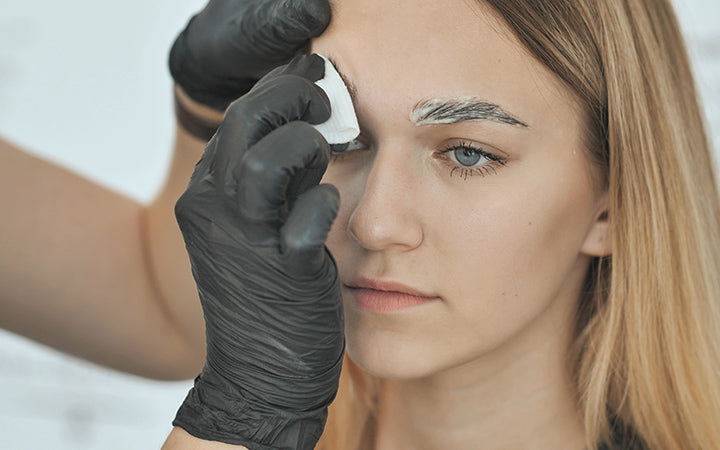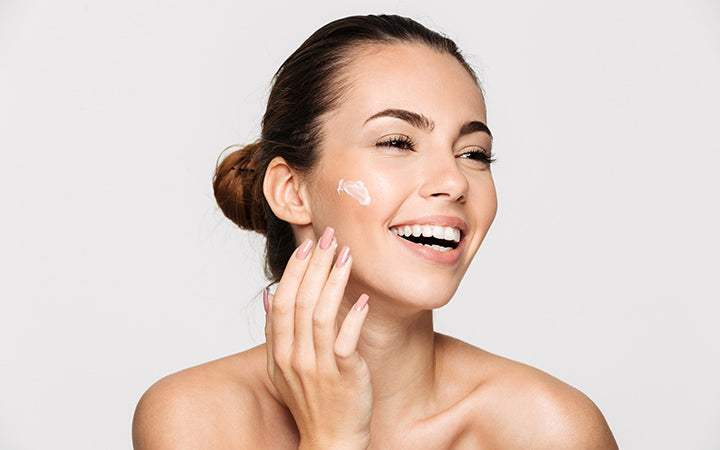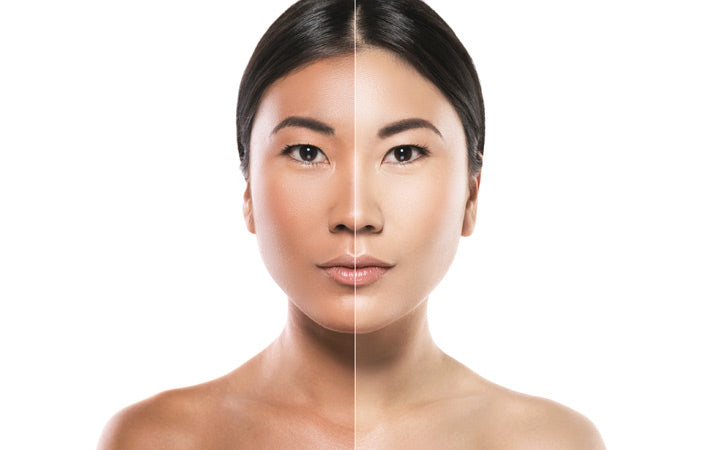We know you are quite particular about your beauty regime. Thus, every time you tan your skin after a vacation or road trip, you reach out for a skin bleach, right?
But, has the debate over safety of skin bleaching left you confused? No worries, we have decided to answer all your queries and give you a crystal clear guidance on bleaching tanned skin. Excited?
Highlights:
- What Is Skin Bleaching?
- Benefits Of Skin Bleaching
- Ingredients Used In Skin Bleach
- How To Bleach Skin At Home?
- Natural Alternatives Of Skin Bleaching
- Side Effects Of Skin bleaching
- Skin Bleaching Vs Skin Lightening
- How Long Does Skin Bleaching Last & How Often To Bleach Skin?
- Which Bleach Is Best For Your Skin Type?
- What To Do When Bleach Burns Your Skin?
What Is Skin Bleaching?
Bleaching agents are often used to lighten the dark, pigmented areas of skin, including blemishes, age spots and freckles. This is known as skin bleaching.
It is done using bleaching creams, soaps, or even a pill. Professional in-office treatments such as chemical peels and laser therapy are also done to address the issue.
But how do bleaching agents work? Your skin colour is determined by the amount of melanin your body produces. Melanin is the natural skin pigment made by the cells called melanocytes.
Everyone has the same number of melanocytes, but the creation of melanin can vary from person to person. People with darker skin have more melanin in their cells. When you use bleach, it minimizes the production of melanin in your skin, giving it a lighter appearance.
Benefits Of Skin Bleaching
- Bleach helps you to get rid of tan and uneven skin tone. The upper layer of your skin gets exfoliated when you rinse off the bleaching cream, making it visibly brighter and glowing.
- Dark spots are mostly caused by sun exposure, hormonal changes, and aging. Skin bleaching treatment can give a temporary solution to hide skin discoloration due to dark spots, acne, and freckles.
- Hiding your facial hair using bleach is a painless process, unlike waxing. You can easily try it at home without any help from others.
Ingredients Used In Skin Bleach
Skin bleach is made of various chemical substances, the chief component being hydrogen peroxide [1]. It decreases the melanin creation in your skin, lightens your facial hair and removes tan. Another known bleaching agent used in skin bleaching is sodium hypochlorite [2]. The interactions between sodium hypochlorite and human skin is a complex method and not fully understood. But it has a similar effect as hydrogen peroxide.
Skin lightening agent Hydroquinone [3] is also used in skin bleach. It cures various types of hyperpigmentation [4]. These bleaching components make your skin appear brighter. It is important to understand that bleaching does not make your skin fair.
How To Bleach Skin At Home?
You should take special care and precautions if you are considering bleaching as an option for your skin. There are several things you need to keep in mind before and after applying the bleach cream.

Precautions To Follow Before Applying Bleach
- Avoid applying bleach to any irritated or injured skin. If you have any skin issues like open wounds or rashes, bleaching would worsen your skin condition.
- Bleach makes your skin sensitive in general. It is advised not to apply any harsh cleanser before using bleach on your skin. It may cause extreme irritation.
- Take a small patch test 48 hours before your actual bleaching schedule. It will work as a safety net for your skin and you will know if your skin reacts to the bleach negatively.
- Do not apply bleach to any sensitive areas of your body like your eyes and eyebrows.
- Keep something cool handy to help you in case of irritation. Ice cubes, chilled water or any cold compress would do the trick.
- Tie up your hair tightly with a band to damage your hair by bleach.
- Every brand gives out a clear set of instructions inside the packet itself. Those instructions need to be followed thoroughly.
Bleaching Procedure
Now that you have conducted a patch test to make sure you are not allergic to bleach, go on with the process to achieve bright skin.
What You Need
1. Face bleach cream
2. Face bleach powder
3. Cotton balls
You may take up to 30 mins approximately or more to bleach your skin with the help of these easy steps.
Step 1: Prep Your Face

Wash your face with cold water and a mild face wash to remove impurities from your face. Try testing the cream on your hand before applying it to the face. Make sure to pick a bleaching cream that suits your skin type to reap the most benefits.
Step 2: Apply The Cream

Take the cream and the powder provided in the bleaching packet and mix it well.
Gently apply the mixture to your face and the areas you want to bleach. Apply it in the direction of hair growth. Make sure you have applied the mixture evenly.
Step 3: Leave The Bleach On For Sometime

Apply a very thin layer of bleach above the lips and apply a heavy layer on your forehead, cheeks and neck. Leave it on your skin for 8 to 15 minutes and not more than that. Exceeding this time can cause itchiness.
Note:
Avoid applying bleach on the under-eye area and the area around the nostrils. It may cause irritation or a burning sensation otherwise.
Step 4: Rinse Off The Bleach

Use clean cotton balls and cool water to rinse off the bleach. Clean your face properly with water. You can use face wash to clean your face but avoid scrubbing your face.
Step 5: Soothe Your Skin

Pat your skin dry with a soft towel. You can run an ice cube all over your face if you feel any kind of uneasiness. Apply a mild moisturizer to let your skin breathe.
Post Bleach Skin Care
- Sunlight increases the production of melanin in your skin. It is best to avoid going out in the sun immediately after you’ve bleached.
- You need to take SPF protection if you step out. Choose the best-suited sunscreen lotion for your skin.
- Frequent bleaching is not advised as it can damage your skin. Repeat your bleaching session only after 4 to 8 weeks of gap.
SkinKraft Tip
Post bleach your skin becomes sensitive. Massaging your skin with Aloe Vera gel for 4 to 5 minutes will give you a soothing relief and also work as an anti-inflammatory agent.
Natural Alternatives Of Skin Bleaching
Not all of us want to use chemical products to bleach our skin. Fortunately, there are several home remedies for skin bleaching being followed for ages. We are listing a few natural options for you below:

1. Lemon Bleach
Vitamin C is extremely beneficial for the skin. Since lemon is enriched with Vitamin C, it has the power to brighten skin, reduce blemishes, and work as a natural bleach.
How to use:
Squish one lemon in a bowl and apply the juice as a face mask for 10 minutes. Rinse it with cool water.
2. Turmeric Paste
Turmeric works as a natural antiseptic. Apart from brightening your skin, it also helps get rid of acne. Turmeric's antioxidants help you to maintain healthy skin as well.
How to use:
Mix 1/2 spoon turmeric along with lemon juice or gram flour. Apply on your skin and leave it for 15 minutes. Clean it off with lukewarm water.
3. Gram Flour Facepack
You can use gram flour as a homemade face pack which will help you lighten your skin. Gram flour keeps excess oil, blackheads, whiteheads, and tan at bay.
How to use:
Mix 1/2 tbsp gram flour and 1/2 tbsp turmeric powder with rose water. Apply the mixture on your skin and leave it for 15 to 20 minutes. Wash it off with lukewarm water.
4. Honey Mix
Honey is antibacterial and has healing powers. It can cure acne, fade blemishes, omit scars and regular usage of honey can lighten your skin tone as well.
How to use:
Mix 1/2 tbsp honey and 1/2 tbsp lemon juice together. Apply the paste on your skin and let it dry for 10 to 20 minutes before you rinse it off.
Side Effects Of Skin bleaching
Bleaching has always been associated with several side effects. Reportedly, many countries have officially declared a ban on bleaching products. The Food and Drug Administration (FDA) [5] has also mentioned in their notice that over-the-counter (OTC) skin bleaching products are not safe.
Here are some of its side effects:
1. Mercury Poisoning
[6]There are few bleaching cream brands that add mercury to their product. Mercury is highly poisonous for skin and it may cause severe damages such as high blood pressure, numbness, fatigue, kidney failure, etc.
2. Skin Inflammation
Bleach is full of chemicals such as sodium hypochlorite which may or may not suit your skin type. If you have sensitive skin, chances of negative reactions are high. It may burn or damage your skin and lead to inflammation.
3. Blue-Black Pigmentation
Long term usage of bleach may land you up in a complicated skin problem. The skin can start getting blue-black pigmentation after a long term usage of bleach. This skin disorder is known as Exogenous ochronosis.[7]
Did You Know?
- OTC skin lightening products are not considered safe by the FDA.
- The FDA does not regulate products marketed as natural bleaching aids.
- Mercury and Hydroquinone [8] are banned in many countries due to the health risk associated with them.
Skin Bleaching Vs Skin Lightening

Skin bleaching and lightening are interlinked. Skin lightening means the reduction of pigmentation, blemishes, acne, and dark spots from your skin. Skin lightening can be done in many ways, bleaching being one of the options. Bleaching fades out the dark spots and blemishes. Even though it does not truly lighten your skin tone, it gives you a lighter appearance.
If you don’t want to worry about which bleach is best for dark skin or which bleach is best for sensitive skin, you can simply opt for peel off skin lightening masks or opt for natural bleach options as mentioned above. Another solution to lighten your skin is a laser treatment, which can be expensive.
How Long Does Skin Bleaching Last & How Often To Bleach Skin?
Bleaching is not a permanent solution for your skin problems like pigmentation. If properly maintained, bleaching effects will last nearly four weeks.
As mentioned before, frequent bleaching your skin may damage your skin. 4 to 8 weeks of gap between each bleaching session is necessary.
Which Bleach Is Best For Your Skin Type?
Now it's time to answer the most asked question. You may want to know which bleach is good for sensitive skin. Well, if you have sensitive and dry skin, it is recommended that you use an ammonia-free, Vitamin C enriched bleach cream or natural alternatives. People with normal skin can choose any bleaching cream which is low on chemical content.
SkinKraft Tip:
Bleaching rashes can be resolved with Lavender oil application on your skin. Your rashes will recover soon without leaving any scar behind!
What To Do When Bleach Burns Your Skin?
If the bleaching cream burns your skin, as an immediate action, wash the affected skin with cold water. Once you rinse off the entire bleaching cream, press a cold compress or gently rub an ice cube on the inflamed skin. Take a doctor's consultation in case of a serious burn or irritation.
Wrapping Up
There is no such considerable health benefit in skin bleaching, besides the fact that it temporarily lightens the skin. Bleaching does not guarantee any long term solution for your skin pigmentation.
We would suggest you talk to your dermatologist in case of any specific query about your particular skin type. It is always best to take advice from a professional.
1. https://pubchem.ncbi.nlm.nih.gov/compound/Hydrogen-peroxide
2. https://pubmed.ncbi.nlm.nih.gov/9378085/
3. https://dermnetnz.org/topics/hydroquinone
4. https://www.aocd.org/page/Hyperpigmentation
5. https://www.fda.gov/drugs/status-otc-rulemakings/rulemaking-history-otc-skin-bleaching-drug-products
6. https://www.ncbi.nlm.nih.gov/pmc/articles/PMC2848228/
7. https://www.ncbi.nlm.nih.gov/pmc/articles/PMC4681189/
8. https://www.who.int/publications/i/item/WHO-CED-PHE-EPE-19.13
Recommended Products
Was this Article helpful?
- Least helpful
- Most helpful














